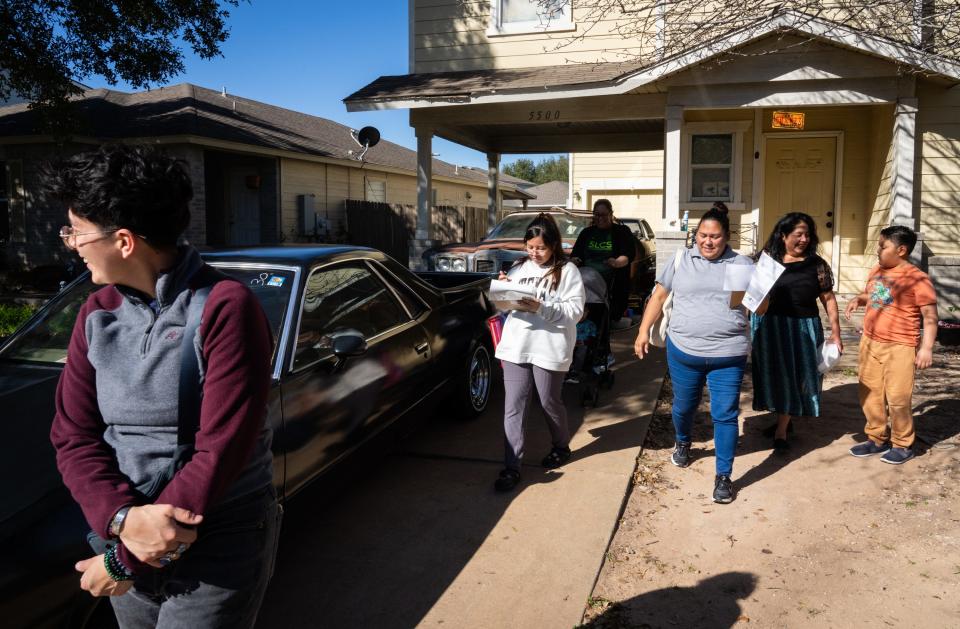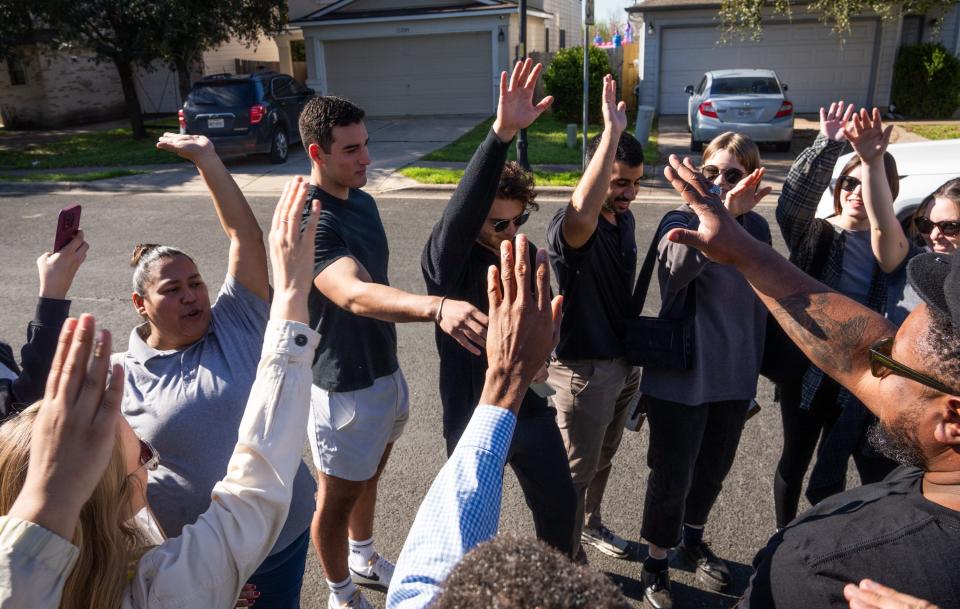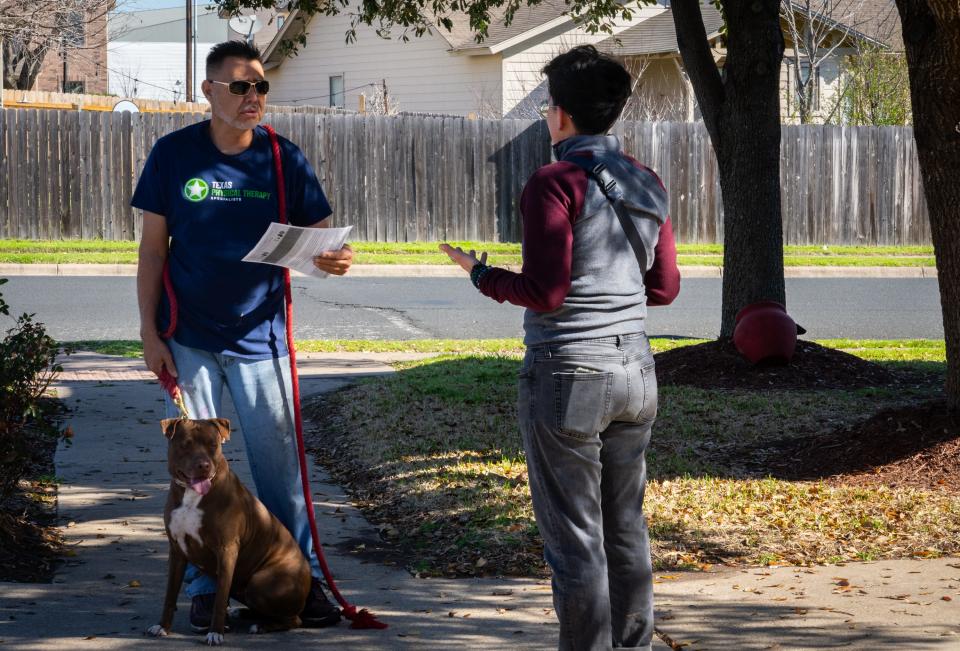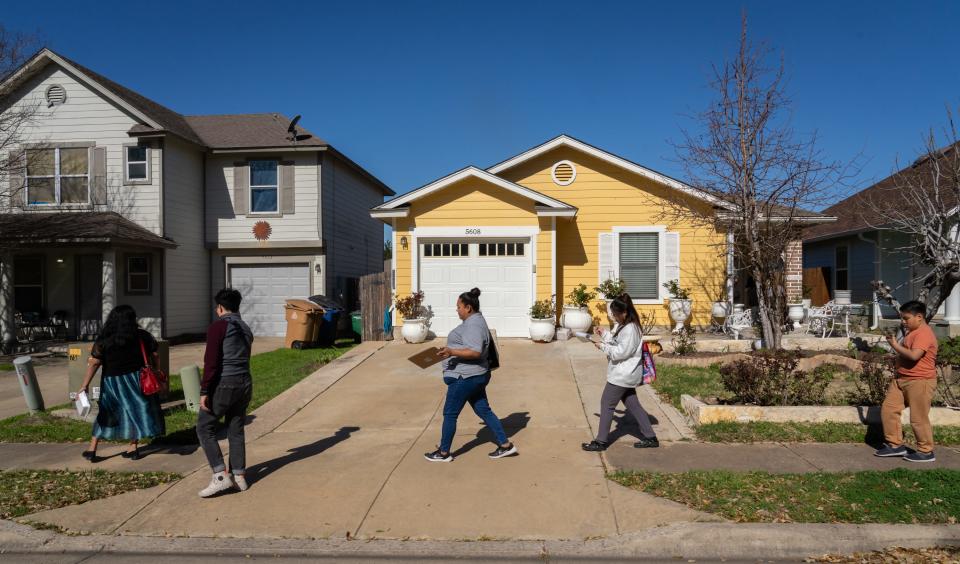A food co-op in Austin's Eastern Crescent? Efforts are underway
DEL VALLE — The four women at the end of the dinner table looked down at their forms and scribbled. They occasionally jerked their necks in thought.
The Del Valle residents were weighing in on a potential food cooperative that could be a solution to the limited grocery options and high prices in their part of Travis County.
Why support a food co-op over a traditional grocery store?
“To support the community. As opposed to making H-E-B rich, we make ourselves rich,” Lupita Salazar said in Spanish as she read from her paper.
The small group had gathered in Del Valle resident Sandra González's home Thursday. Erica Reyes, organizer for the advocacy group Go Austin/Vamos Austin, explained to the women the fundamentals of a food cooperative. To each, the idea of a store owned and controlled by the community was novel, but the arguments made sense: This was an opportunity for a food market that responded directly to them.

Reyes was candid: The effort was young, and many decisions remained, among them where such a store would go and how it would be fully funded.
But, Reyes said, “we have the advantage of having the city’s support, of having a representative who says they want this.”
House meetings like this one are part of an effort to reconsider the food system in Austin’s Eastern Crescent, a belt of traditionally economically disadvantaged and often nonwhite neighborhoods, which are also more likely than other parts of the city to face food insecurity due to limited grocery options, as well as a combination of economic, transit and cultural barriers. With city money, organizing is now underway.
More: Del Valle residents continue calls for better food access, an H-E-B
How close to reality is an Austin community food co-op?
Talks about a food cooperative remain in the early stages. In 2021, the Austin City Council allocated $500,000 from the American Rescue Plan Act to plan and design a community-controlled grocery store through a budget rider sponsored by Council Member Vanessa Fuentes. It awarded a coalition of organizations, including the health-focused GAVA, the development contract and the first $300,000 in 2022.

In the year and a half since, local leadership has educated on co-ops, gauged community needs and priorities, and explored financial possibilities. A community steering committee also formed. It will make the ultimate decisions on how the co-op takes shape, including what proposal is presented to the city.
To receive the final $200,000, the steering committee must present 300 pledges and a feasibility analysis, showing wants, needs and a market study. Local leadership hopes to complete this by the end of the year.
To date, Reyes has focused on collecting interest forms. After a preliminary location, a funding plan and membership details are in place, organizers will begin to collect pledges, she said. The committee has yet to propose a location, but it is studying three in the Eastern Crescent, said Drew de los Santos, executive director of the Austin Cooperative Business Association, who is working on the financial plans.
Many of those involved in the project want a full-service brick-and-mortar grocery store, but the project could take another shape. The committee has also discussed a cooperative mobile food truck or food distribution club, perhaps as a step to a full store.
De los Santos said that early estimates suggest a brick-and-mortar co-op in Austin would cost about $5 million to $10 million.

In a decisive year, organizing efforts ramp up
The Thursday meeting was the second this month organized at González’s home. These, along with a canvassing event in late February, represented an effort by Reyes to increase outreach in the neighborhood.
Salazar said she came because a grocery store is necessary to improve the quality of life of residents. Since moving to Del Valle three years ago, she has struggled to accept the serious inconveniences she didn’t experience at her previous Austin addresses.
““You get here, and it’s a surprise,” she said.

González and Lulú Martínez, an attendee, nodded along. All three rented off North Lamar Boulevard for many years before moving to Del Valle to buy. It seemed the rational idea, Salazar said. It seemed more affordable. She didn’t consider what she says are the hidden costs to living in Del Valle: “It’s time, gas and my evenings.”
The five Del Valle residents had stories about the elevated prices at the local mini marts they must use when they can't drive into town. Martínez, for example, said milk can be seven or eight dollars a gallon at one of these stores.
Martínez said she had come because she was tired of waiting for an H-E-B.
Since 2016, H-E-B has held property off Texas 71 and FM 973. It has never given a timeline for the project, despite persistent community calls for it. Leslie Sweet, H-E-B’s director of public affairs for Central Texas, told the American-Statesman in December that the company often purchases property “well in advance of our current real estate needs" and that it has "future aspirations" to open a Del Valle store.

Martínez also wanted better access to healthy foods.
“People think that we as Latinos don’t care about that,” she said in Spanish. “But I do, especially if it’s at a fair price.”
Could a ‘national movement’ offer an alternative to waiting on companies?
Austin's effort for a grassroots-led food cooperative follows a trend as other cities have similar projects.
Gem City Market opened in 2021 in the predominantly Black, historically redlined and storeless northwestern part of Dayton, Ohio. Detroit People’s Food Co-op is scheduled to open in May in a similar neighborhood. In North Carolina, store projects in Charlotte and Raleigh continue fundraising and financing campaigns with the hope of opening within two years.
In the case of the two completed projects, a physical store took seven-plus years and millions of dollars. The results reflect constant organizing, the participation of thousands of residents, and ambitious financial plans and fundraising.

Gem City President Amaha Sellassie said the group connected with its community through conversations about food apartheid, the theory that ties the separation of healthy food from poor and nonwhite communities to the country’s history of racism, suggesting it is purposeful.
Gem City is now in its third year. After two shaky years, conditions are stabilizing, and the market expects to break even this year, Sellassie said. Store leadership expected it to take four years.
Malike Yakini, an early organizer of the Detroit People’s Food Co-op, said an early obstacle he confronted was the “collective doubt” of community members who had seen decades of previous promises from nonprofits go unfulfilled. (During the Del Valle block walk, Austin organizers ran into some of this, with several residents saying they had seen previous efforts for a grocery store come and go.)
Later, he said, the group had to confront doubts from financiers that the community’s economic muscle could sustain a store. A majority of the store's financing came six to eight years into organizing.
“There’s economic capacity in communities that traditional market studies don’t recognize, because they don’t really understand the culture,” Yakini said, referencing the informal economy — for example, people doing others' hair at their homes to make money — and a report by the National Black Food and Justice Alliance.

Sellassie and Yakini hope their stores are the first in a national wave of co-ops that prioritize underserved communities. They should be "the norm for Black and brown communities," Yakini said.
The path ahead
As the Del Valle meeting wound down, the women brainstormed about other community members they could engage and planned a community town hall with Fuentes, the council member.
The effort has few guarantees. None of the women is on the steering committee. It's unclear how the effort will pay for itself after the city’s initial $500,000 runs out.

But those present agreed that the status quo isn’t working. No grocery company has taken the full bet on Del Valle. It was up to them to share their experiences and imagine a solution.
“I know that it’s not easy, that it’ll take a lot of hard work … a lot of time,” Martínez said the day after the meeting.
But “it would excite us to be able to shop there, knowing that the prices are fair, that there are organics, things that are healthy for us," she said. “There’s a lot of people here. A lot, a lot of people. Something has to be done."
This article originally appeared on Austin American-Statesman: In Austin's Eastern Crescent, communities organize for a food co-op

